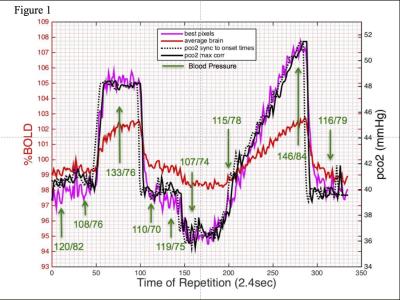Synopsis
The interest in translating MRI mapping of cerebrovascular reactivity
(CVR) for the clinical assessment of hemodynamic insufficiency secondary to
cerebrovascular disease is increasing. This presentation will focus on the
current issues and potential solutions facing widespread dissemination of this
methodology. Issues regarding the flow stimulus, flow sensitive pulse
sequences, data analysis, and clinically relevant detection thresholds will be presented.
Acknowledgements
No acknowledgement found.References
1.
Gupta A, Baradaran H, Schweitzer AD, Kamel H,
Pandya A, Delgado D, Wright D,
Hurtado-Rua S, Wang Y, Sanelli PC. Oxygen
extraction fraction and stroke risk in patients with carotid stenosis or
occlusion: a systematic review and meta-analysis. AJNR Am J Neuroradiol. 2014
Feb;35(2):250-5. doi: 10.3174/ajnr.A3668. Review. PubMed PMID: 23945227.
2. Spano VR, Mandell DM,
Poublanc J, Sam K, Battisti-Charbonney A, Pucci O, Han JS, Crawley AP, Fisher
JA, Mikulis DJ. CO2 blood oxygen level-dependent MR mapping of cerebrovascular
reserve in a clinical population: safety, tolerability, and technical
feasibility. Radiology. 2013 Feb;266(2):592-8. doi:10.1148/radiol.12112795.
PubMed PMID: 23204541.
3. Hoge RD, Atkinson
J, Gill B, Crelier GR, Marrett S, Pike GB. Investigation of
BOLD signal dependence on
cerebral blood flow and oxygen consumption: the
deoxyhemoglobin dilution model.
Magn Reson Med. 1999 Nov;42(5):849-63. PubMed
PMID: 10542343.
4. Sobczyk O, Battisti-Charbonney A, Poublanc J,
Crawley AP, Sam K, Fierstra J,
Mandell DM, Mikulis DJ, Duffin
J, Fisher JA. Assessing cerebrovascular reactivity
abnormality by comparison to a
reference atlas. J Cereb Blood Flow Metab. 2015
Feb;35(2):213-20. doi:
10.1038/jcbfm.2014.184. Epub 2014 Nov 12. PubMed PMID:25388679.
5. Sobczyk O, Crawley AP, Poublanc J, Sam K,
Mandell DM, Mikulis DJ, Duffin J,
Fisher JA. Identifying
Significant Changes in Cerebrovascular Reactivity to
Carbon Dioxide. AJNR Am J
Neuroradiol. 2016 May;37(5):818-24. doi:
10.3174/ajnr.A4679. PubMed PMID:
26846924.

